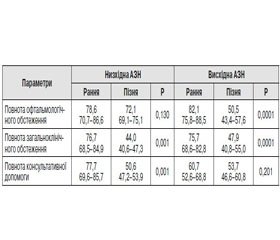Международный неврологический журнал 2 (72) 2015
Вернуться к номеру
Neurological aspects of optic nerve atrophy
Авторы: V.A. Vasyuta
Рубрики: Неврология
Разделы: Клинические исследования
Версия для печати
The optic nerve is anatomically connected with the central nervous system. Anatomical relationship makes communication in ophthalmic and neurological disorders. About 40% of the optic nerve atrophy associated with various diseases of the central nervous system. Optic nerve atrophy is divided into upward and downward, depending on the level of damage to the optic nerve.
The pathology of the central nervous system (trauma, inflammation, compression of the nerve fibers) leads to downward optic nerve atrophy. Rising optic nerve atrophy results from inflammation in the optic nerve, vascular disorders of the optic nerve. Without comprehensive ophthalmologists and neurologists interaction, it is very difficult to help patients with this disease. Current issues is early detection of this disease when treatment is most effective.
The aim was to investigate the etiological factors of optic nerve atrophy during 2014 study, analyze the prognostic significance of individual parameters that can influence on the frequency of early diagnosis.
Materials and methods. Investigated patients who applied to the neuroophtalmological department of «Institute of Neurosurgery» during 2014 year. The structural distribution of patients with optic nerve atrophy is presented in Table 1.
Results. Note the high percentage of brain tumors supratentorial localization 79.4% (75,9-82,9) that cause the development of optic nerve atrophy. We studied the etiological factors of optic nerve atrophy unrelated with diseases of central nervous system. In the first place among the causes of the optic nerve atrophy is a vascular factor – 28 % (19,2-36,8), the second - inflammation 27 % (18,3-35,7), the third - traumatic 17% (9,6-24, 4).
The next stage of our analysis was to study the prognostic significance of parameters that can influence the rate of early diagnosis of the optic nerve atrophy. It is very important not only examine patients by ophthalmologists, but also to guide the consultation mainly to neurologists and general clinical examination.
This main group of examination was group with early diagnosis of optic nerve atrophy (up to 3 months after the first appeal). The control group were patients with late detection (more than 3 months after initial treatment). The following parameters were studied: the completeness ophthalmologic examination, completeness general clinical examination, completeness advisory assistance (doctors related disciplines). Conducted determination of the probability (in terms of the odds ratio) early diagnosis of optic nerve atrophy in the presence of each of the parameters. Factor completeness ophthalmological examination shows no significant importance for early diagnosis descending optic nerve atrophy (p = 0.13), but significantly more common in the group of early diagnosis of ascending optic nerve atrophy (82.1% and 50.5% with late diagnosis, p = 0.001). Completeness general clinical examination is an important prognostically significant parameter for early detection of both types of disease (p = 0.001). Factor completeness consulting assistance not substantially prevail in the group of early diagnosis in ascending optic nerve atrophy (p > 0,05), but significantly more present in the group with early diagnosis descending optic nerve atrophy (77.7 and 85.4%, p = 0.001).
Conclusions. We conducted a study of structural characteristics is optic nerve atrophy. Among the diseases of central nervous system detected a high percentage of brain tumors as a cause of optic nerve atrophy, among ophthalmic factors prevailing vascular and inflammatory factors. Studied the prognostic significance of the parameters that affect the rate of early diagnosis of optic nerve atrophy. Factor completeness ophthalmological examination shows no significant importance for early diagnosis descending optic nerve atrophy (p = 0.13), but significantly more common in the group of early diagnosis of ascending optic nerve atrophy (82.1% and 50.5% with late diagnosis, p = 0.001). Completeness general clinical examination is an important prognostically significant parameter for early detection of both types of disease (p = 0.001). Factor completeness consulting assistance not substantially prevail in the group of early diagnosis in ascending optic nerve atrophy (p > 0,05), but significantly more present in the group with early diagnosis descending optic nerve atrophy (77.7 and 85.4%, p = 0.001).

